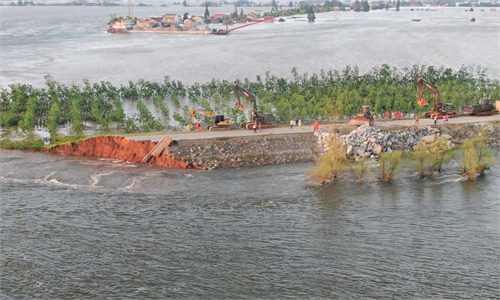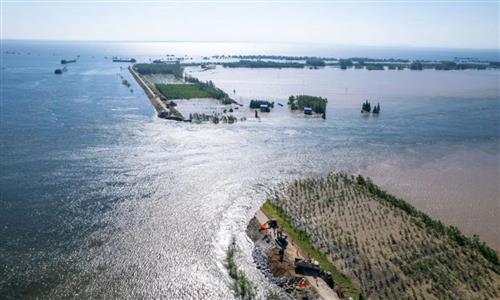
An aerial drone photo shows rescuers working to block the dike breach in the Dongting Lake in Huarong county, Central China's Hunan Province, on July 7, 2024. Photo: Xinhua
With endeavors from all sectors of society, the 226-meter-long dike breach at Dongting Lake, China's second-largest freshwater lake in Central China's Hunan Province, was sealed on Monday night with the restoration work proceeding from both land and water.
Zhang Yingchun, an executive vice governor of Hunan Province, said during the briefing that great efforts have been made to proceed the repairs to the breach as quickly as possible, with 485 personnel as well as 3,180 dump trucks and 85 vessels of all types being put into use without interruption.
The restoration of the dike, which started on Saturday afternoon, has accelerated since Sunday morning after the water level differences in and outside the breach narrowed and the water flow slowed down.
Rescue forces dumped rocks and raw materials into the water from four barges that contain 2,000 cubic meters of rock, while also combining the river closure measures of transverse dumping and end dumping. With these methods, experts estimated that the dike can be rebuilt at a speed of 3-4 meters per hour, the equivalent of 60 meters to 80 meters each day.
As the repairs proceeded in an orderly manner, the gap narrowed and the water flow speeded up, which caused the dumped sand and gravel to be easily washed away, increasing the difficulty of plugging the gap, an employee from China Anneng Construction Group Corp Ltd, one of the main forces undertaking the repair operation, told the Global Times on Monday.
Zhang Lirong, chief engineer from Anneng added during the Monday briefing that the biggest difficulty is that the breach with a width of 226 meters and an average water depth of more than 10 meters constitute a significant amount of work with diversified blocking material sources and long distance of transportation.
To address these difficulties, blocking materials are dumped from both land and water routes and the traffic was coordinated to assure the transportation of the materials.
"We have developed a plan to simultaneously use land and water routes for dumping and blocking, based on the conditions of the site's roads and waterways. We are enhancing traffic guidance and on-site coordinated command, and optimizing the techniques for mixing and dumping various material sources," Zhang said.
These difficulties were soon resolved in an orderly manner, according to Zhang.
Two cases of dike piping were identified on Monday morning at the 14.35-kilometer-long embankment, viewed as "the second line of defense" located between the breached dike in Tuanzhou township and the next dike in southern Qianlianghu township.
The main function of the embankment is to prevent the next embankment area from being flooded by acting as a barrier when a breach or overflow occurs in the forefront dike.
PLA officers and soldiers in Hunan Province rushed to the scene to carry out the emergency operations, according to the China Central Television (CCTV) Military Report.
Several dump trucks carrying sand and gravel arrived at the scene in less than 15 minutes. In addition, large self-unloading barges quickly transported a large amount of rocks and raw materials to the section of dike where the piping occurred.
According to experts from Hunan Provincial Department of Water Resources, the piping has been brought under initial control through efforts made by more than 300 rescue personnel, including armed police and firefighters who conducted emergency operations under the guidance of experts from the provincial department of water resources.
The PLA Southern Theater Command Air Force on Sunday night dispatched more than 700 officers and soldiers and 46 vehicles to Yueyang to carry out flood control and rescue tasks. Moreover, the PLA air force carried out tasks of patrolling and enforcing the dikes and production and life resumption tasks.
China's Ministry of Water Resources on Monday conducted consultation analyses and assessed the rainfall, water conditions, and flood situations in the Yangtze River, Huaihe River, and Yishu River basins, maintaining the Level-III flood control emergency response for East China's Anhui and Jiangxi provinces and Central China's Hubei and Hunan provinces, maintaining the Level-IV flood control emergency response for Northeast China's Heilongjiang Province, East China's Shandong and Jiangsu provinces and Southwest China's Chongqing Municipality, CCTV reported on Monday.
It is expected within the next 24 hours, water levels in Luoshan section, Dongting Lake, Taihu Lake in the middle and lower reaches of the Yangtze River will recede below warning levels whereas the water levels in Lianhuatang in Yueyang, the section between Jiujiang and Datong River, Poyang Lake and Xiushui county will remain above warning levels.


